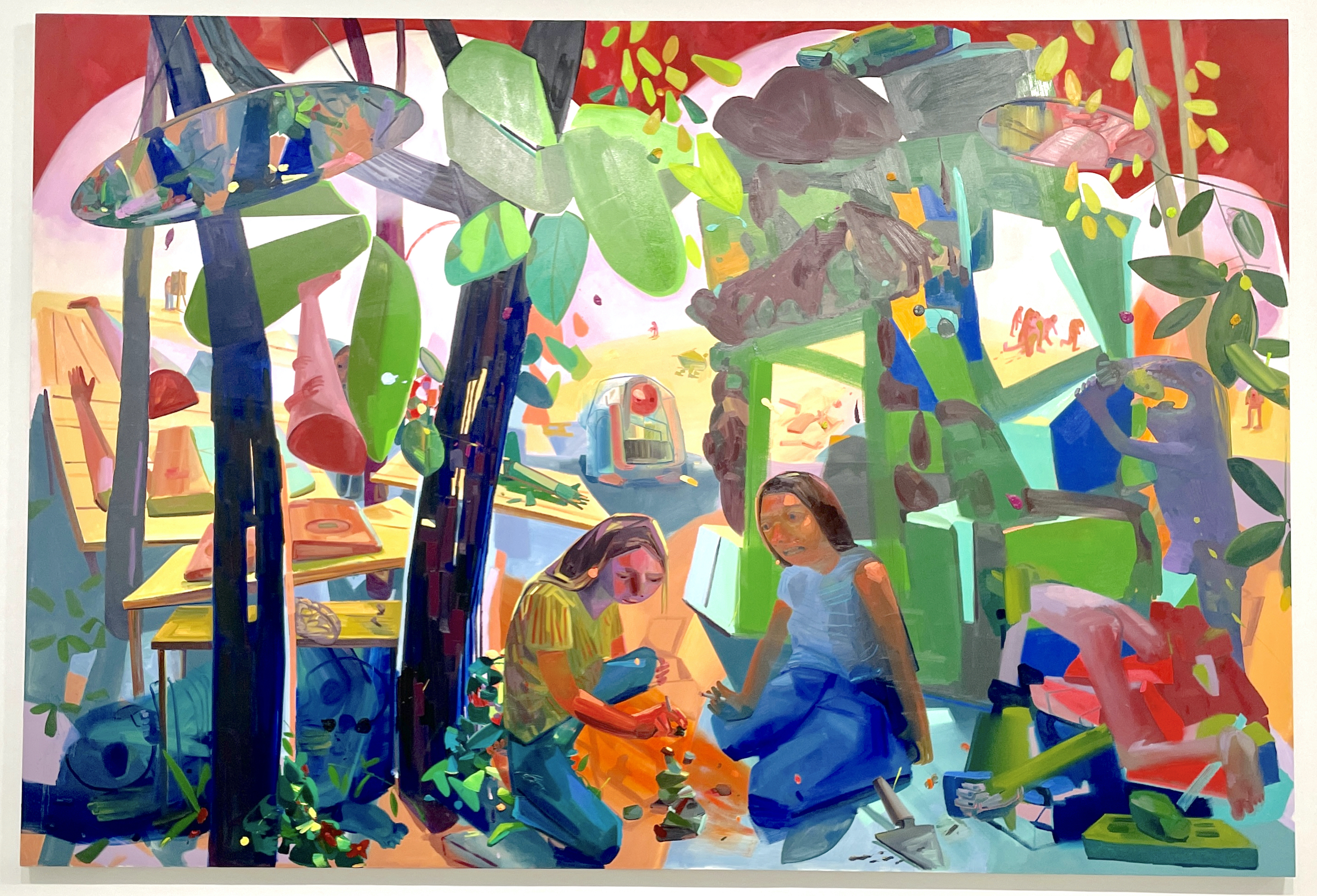
Downtown Bentonville (all photos by the author for Hyperallergic)
BENTONVILLE, Ark. — “Capital isn’t scarce; vision is.” This flippant platitude was once uttered by Sam Walton, the founder of the importunately ubiquitous Wal-Mart empire. One wonders what “Mr. Sam” would have to say about that after taking a gander at Bentonville today, the pint-sized hometown of one of his first successful stores, in northwestern Arkansas, where certainly neither capital nor vision are scarce. Then again, he also once opined that “high expectations are the key to everything,” and this cannot be denied in conjunction with Bentonville.
Now, before you start pooh-poohing Arkansas as a backwater and before you get all high-and-mighty with your moral convictions pertaining to Wal-Mart’s position as one of the largest corporations in the world — not that, you know, any other museums receive funding from major corporations — hear me out. Bentonville is a remarkable place to get your art on, and first-rate art, at that. I say this despite the fact that the Walton family’s fingerprints are everywhere, from the kitschy time capsule five-and-dime soda jerk referencing the family’s humble roots in the town square (now home to the Wal-Mart Visitor’s Center, where you can learn just about everything you never wanted to know about said franchise, followed by a 99-cent dollop of ice cream) to the preservation and realization of much of the town’s basic infrastructure, to, of course, the newly minted Crystal Bridges Museum of American Art.

The 21c Museum Hotel in Bentonville
Say what you will about big corporations and Wal-Mart’s capitalistic wet dream come true; Wal-Mart money has certainly done right by this neck of the woods, initiating what appears to be a ripple effect of positive cultural initiatives, not all of which have been funded by the franchise. Take, for instance, the most recent incarnation of the 21c Museum Hotels (the museum-cum-hotel brainchild of collectors Laura Lee Brown and Steve Wilson), which recently opened in downtown just shy of the main square. Such an interest in little ol’ Bentonville likely would not have been heard of before Crystal Bridges opened its doors. It’s a bit of an “if you build it, they will come” scenario in this modest community, demonstrating that if you provide the infrastructure to engage with the arts, it will indeed be utilized and maybe even deeply appreciated. More often than not, as very much appears to be the case with Bentonville, it will serve as a catalyst for future community-based initiatives, attracting like-minded projects spurred on by the initial initiative.
When it comes to experiencing art in this former whistle-stop, if you want to focus on primarily emerging but also more established 21st-century artists, you can keep your house slippers on and meander about the 21c Museum Hotel’s galleries, peppering your visit with the occasional dip into The Hive, the hotel’s in-house restaurant. The hotel has both rotating and permanent exhibitions, and most of the art on view is culled from the sizeable and diverse private collection of the establishment’s co-founders, supplemented by loans. Featured are works by video artists Bill Viola and Tony Oursler; photographers Andres Serrano, Sam Taylor Wood, and David Levinthal; sculptors Yinka Shonibare and Judy Fox; and multimedia artists Chuck Close, Alfredo Jaar, and Kara Walker, among others. Upon the occasion of this particular visit, the hotel had mounted a fantastic exhibition called Hybridity: The New Frontier, which considered the diminishing boundaries between animal and human, nature and technology. The spacious, open-plan galleries are situated in a way that allows for seamless transitions from inside to outside, room to room. The attached hotel courtyard serves as additional gallery space, and the rooftops are scattered with sculptures. Sitting outside by the fire pit around evening tide is nothing short of pleasant.
I particularly enjoyed a permanent piece by artist and arborist Sam Van Aken located in an interior courtyard, viewable from the lobby or the restaurant, titled “Tree of 40 Fruit,” consisting of an actual fruit tree grafted to grow forty varieties of stone fruit, including peach, plum, apricot, nectarine, cherry, and the hybrid species therein. Also of note, not to mention endlessly amusing, was a 14-screen video installation by the British artist Marcus Coates titled “Dawn Chorus,” which mutates the sounds of highly prosaic activities from humans and birds. The artist collected 500 hours of birdsongs, which were subsequently slowed down by 16 times, then got choral singers to mimic the chirps, whines, and groans. He then sped up the videotapes, turning the footage into a veritable human aviary.
Of course, you could fill your entire visit loafing about the hotel, but the trek down South would not be complete without giving Crystal Bridges a try. The museum’s core collection is arranged chronologically, which might sound a bit irksome at first. It did to me. To be quite frank, I was dreading taking the timeline train through American Art 101. Been there, done that in a collegiate spasm of yore, thank you very much. And yet, oddly enough, for the space, it actually worked. The unique meandering architecture of the museum, designed by Israeli Canadian architect Moshe Safdie, somehow alleviated the linearity, so that pieces addressed and cross-referenced one another across rooms and galleries, inside and outside.

The Crystal Bridges Museum
Admittedly, the nascent core collection on display does essentially amount to American Art 101, from Colonial to contemporary (take that last bit with a grain of salt, though, as it still seems to be in development), with a couple of glaring gaps here and there. I could see why all the bigwig museums in the North were up in arms about a great bulk of important art being sent off “to the middle of nowhere”: this collection is really quite jaw-dropping. I can imagine that it will serve as an excellent teaching collection, if appropriately taken advantage of, and from what I’ve seen thus far, I believe it will be. Supplementing the core collection is modest gallery space for rotating exhibitions. There’s much potential here for fantastic, interdisciplinary shows.
One of the most astonishing aspects of visiting Bentonville was something that I couldn’t quite put my finger on initially but finally pinned down to noise. Not the sound of crickets crooning at night or the untroubled commotion of daily activity, but the sound of interested and involved voices in the presence of art. The galleries at Crystal Bridges, as well as the hotel’s museum, were chock-full of voices excitedly commenting on and engaging with the works in front of them. And not in a petty, kind of pedantic way, but in a curious, truly engaged manner. The bulk of these visitors were locals, or from surrounding regions, as indicated by a particular Southern lilt. A visit to these two locales will easily dispel any kind of broad assumptions you might have about Southern aesthetic preferences. This is a whole different caliber of hayseed. Most noise habitually encountered in museums and galleries can be classified as white noise at best; these galleries were positively teeming with vocalized curiosity from all ages and walks of life. It was that rare occasion when art seems to be doing its job, and it was marvelous.
Bentonville strikes just about the right chord of equal parts sleepy and vibrant. If it can somehow manage to maintain this state, it will be nothing short of miraculous, given the usual course of gentrification. Though, perhaps to even mention gentrification in the same breath as what’s happening in this small community is unfair, at least at the time of this article. There is, for instance, a refreshing absence of hipsters, the appearance of whom usually indicates a plague upon all things earnest and well executed. Men found in town wearing suspenders and touting facial hair do so out of practicality or habit. The welcome dearth of irony is enough to make this writer return again and again. What’s more, the approach taken and the response given to art in this community are incredibly accessible and engaging without an ounce of pretension. Key among these approaches is the concept of open access. Both Crystal Bridges and the contemporary art museum in the 21c Museum Hotel offer free admission. The latter goes a step further, taking the concept of open access at face value, with galleries open to the public, not just hotel guests, 24/7. The former has scads of outdoor art trails that can be accessed by foot or cycle from dawn to dusk, and sometimes even later. There’s also a clutch of art galleries in town and many outdoor public art installations. So, there’s really no excuse not to get your art on. Ever.
* * *
A perfect jaunt to Bentonville would entail:
Check in at the 21c Museum Hotel in the afternoon and gawk at the brilliance of its concept for a solid couple of hours. Art is lurking everywhere: inside, outside, in the rooms, in the gym, on the roof, in the elevators, sometimes even perambulating about the corridors. So much so, in fact, that sometimes it feels a bit like that part in Willy Wonka and the Chocolate Factory where Wonka leads the contestants down a hallway exclaiming happily that even the walls are palatable. The gym includes a permanent piece by Virginie Barré featuring an obese batman; titled “Fat Bat,” it amuses and inspires as you break a sweat. In-room you can tune in to video art on a special hotel channel. Art on the walls, art in the bathroom, but somehow it is tastefully done, so that you aren’t nauseous by the end of it.
You could easily spend your entire spree in the hotel alone, but get yourself out to the trails around Crystal Bridges, saving the beast itself for the following morning. “Skyspace: The Way of Color,” a stunning James Turrell piece, is located about a three-minute walk from the hotel on these trails, and it lights up just after dusk. It is well worth the (hardly strenuous) trek.

James Turrell’s “Skyspace: The Way of Color” on the grounds of Crystal Bridges
Stumble back with that signature dazed stupor afforded by Turrell to the hotel to dine at its in-house restaurant, The Hive. You’ll want to make an evening of it, starting with one of their delicious (often bourbon or rye-based) cocktails, followed by a bevy of tasty dishes inspired by and sourcing local ingredients such as persimmons, pecans, wild quail, black walnuts, and sweet onions. The chef apparently sources entire beasts when possible, so make your selection after having picked the waiter’s brain as to what the choicest dishes of the evening might be. Waddle happily back to your room, trying not stop and look at more art. Sleep it off, grab a crepe from the adorable little crepe stand right outside the hotel, walk around downtown a bit and see what they know, then hightail it out to Crystal Bridges You’ll likely want the better part of your day for this visit, if you take in the art on the grounds, too, and you should. All of it. Head back to town in an art coma, collect your senses, and make a beeline to the Flying Fish before all the locals beat you to the best no-frills, delicious seafood in town. Save room for desert at The Hive afterwards.
The 21c Museum Hotel is located at 200 NE A Street, Bentonville, Arkansas. Its galleries are open 24 hours a day, 7 days a week, 365 days a year.
The Crystal Bridges Museum of American Art is located at 600 Museum Way, Bentonville, Arkansas. Visitor hours and information can be found online.
SOURCE: Hyperallergic – Read entire story here.







